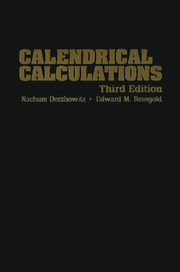Book contents
- Frontmatter
- Dedication
- Contents
- List of Frontispieces
- List of Figures
- List of Tables
- Abbreviations
- Mathematical Notations
- Preface
- Credits
- License and Limited Warranty and Remedy
- About the Cover
- 1 Calendar Basics
- I ARITHMETICAL CALENDARS
- II ASTRONOMICAL CALENDARS
- 13 Time and Astronomy
- 14 The Persian Calendar
- 15 The Bahá'í Calendar
- 16 The French Revolutionary Calendar
- 17 The Chinese Calendar
- 18 The Modern Hindu Calendars
- 19 The Tibetan Calendar
- 20 Astronomical Lunar Calendars
- Coda
- III APPENDICES
- Index
- Envoi
- About the Cover
14 - The Persian Calendar
Published online by Cambridge University Press: 05 February 2014
- Frontmatter
- Dedication
- Contents
- List of Frontispieces
- List of Figures
- List of Tables
- Abbreviations
- Mathematical Notations
- Preface
- Credits
- License and Limited Warranty and Remedy
- About the Cover
- 1 Calendar Basics
- I ARITHMETICAL CALENDARS
- II ASTRONOMICAL CALENDARS
- 13 Time and Astronomy
- 14 The Persian Calendar
- 15 The Bahá'í Calendar
- 16 The French Revolutionary Calendar
- 17 The Chinese Calendar
- 18 The Modern Hindu Calendars
- 19 The Tibetan Calendar
- 20 Astronomical Lunar Calendars
- Coda
- III APPENDICES
- Index
- Envoi
- About the Cover
Summary
It was the custom of the Persians not to begin a march before sunrise. When the day wasalready bright, the signal was given from the king's tent with the horn; above the tent, from which it might be seen by all, there gleamed an image of the sun enclosed in crystal. Now the order of march was as follows. In front on silver altars was carried the fire which they called sacred and eternal. Next came the Magi, chanting their traditional hymn. These were followed by three hundred and sixty five young men clad in purple robes, equal in number to the days of the whole year; for the Persians also divided the year into that number of days.
—Quintus Curtius Rufus: History of Alexander, III, iii (circa 35 C.E.)The modern Persian calendar, adopted in 1925, is a solar calendar based on the Jalālī calendar designed in the eleventh century by a committee of astronomers, including a young Omar Khayyām, the noted Persian mathematician, astronomer, and poet. The Jalālī calendar had 12 months of 30 days each, followed by a 5-day period (6 in leap years), just like the Coptic/Ethiopic calendar described in Chapter 4. In addition to the Jalālī calendar, the Zoroastrian calendar, whose structure is described in Section 1.9, was also used historically in Persia.
- Type
- Chapter
- Information
- Calendrical Calculations , pp. 217 - 228Publisher: Cambridge University PressPrint publication year: 2007



